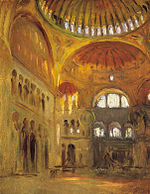|
Dome

Interior of the Hagia Sophia by John Singer Sargent, 1891
The dome of Hagia Sophia is carried on four concave triangular pendentives, a form which was first fully realized in this building. The pendentives serve to transition from the circular base of the dome to the rectangular base below. These were reinforced with buttresses during Ottoman times, under the guidance of the architect Mimar Sinan. The weight of the dome remained a problem for most of the building´s existence. The original dome collapsed entirely in 558; in 563 a new dome was built which included ribbing and was slightly taller than the original. Larger section of the second dome collapsed as well, in two portions. The present dome consists of two sections at the north and south that date from the 562 reconstruction. The north section covers an area of 8 ribs of the whole dome’s 40, while the south section includes 6 ribs.
The dome has spurred particular interest for many art historians, architects and engineers because of the innovative way the original architects envisioned the dome. The dome is supported by pendentives, which not only restrain the lateral forces of the dome and allow its weight to flow downwards, but also achieve a pleasing aesthetic quality by enabling the dome to transition gracefully into the square shape of the space below.

The face of one of the seraphim in the upper left corner, once covered during the Fossati Brothers restoration, is visible again.
Although this design stabilizes the dome and the surrounding walls and arches, the actual construction of the walls of Hagia Sophia weakened the overall structure. The bricklayers used more mortar than brick, which weakened the walls. The structure would have been more stable if the builders at least let the mortar cure before they began the next layer; however, they did not do this. When the dome was placed atop the building, the weight of the dome caused the walls to lean outward because of the wet mortar underneath. When Isidorus the Younger rebuilt the original dome, he had to first build up the interior of the walls so that they were vertical in order to support the weight of the new dome. Additionally, Isidore the Younger raised the height of the rebuilt dome by approximately six metres so that the lateral forces would not be as strong and the weight of the dome would flow more easily down into the walls.
Another interesting fact about the original structure of the dome was how the architects were able to place forty windows around the base of the dome. Hagia Sophia is famous for the mystical quality of light that reflects everywhere in the interior of the nave, which gives the dome the appearance of hovering above the nave. This design is possible because the dome is shaped like a scalloped shell or the inside of an umbrella with ribs that extend from the top of the dome down to the base. These ribs allow the weight of the dome to flow between the windows, down the pendentives, and ultimately to the foundation.
The unique character of the design of Hagia Sophia shows how this structure is one of the most advanced and ambitious monuments of late antiquity.
http://en.wikipedia.org/wiki/Hagia_Sophia
|

